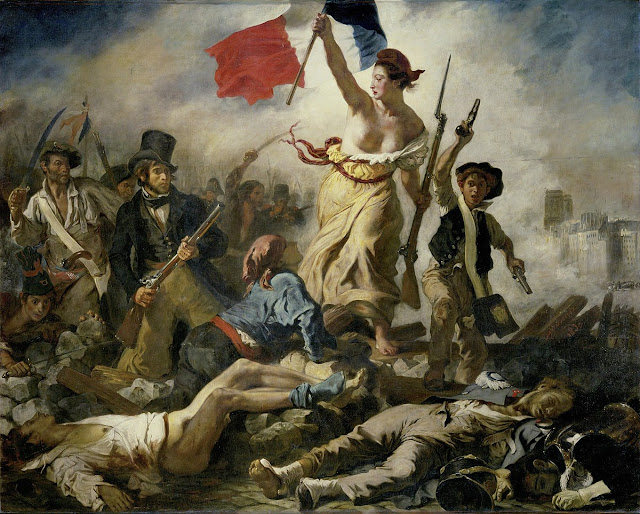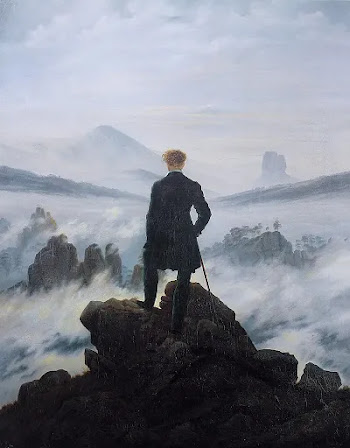The French Revolution and Art
The French Revolution and Art
 |
Liberty Leading the People by Eugène Delacroix (1830) Painted in France |
This piece created by Eugène Delacroix depicts an armed woman leading a ragged group of followers to victory against what can be presumed to be enemies of liberty. it was painted in the revolutionary environment of early 1800s France, after the first republic had fallen but before the second republic took power.
The painting is directly linked to, and inspired by, the French Revolution and its Enlightenment-era ideals. The ideals presented are that societies shouldn't be led by a small number of elites but rather by the consensus of the masses. That idea can be seen here in Delacroix's work which shows a group of commoners led by a woman standing atop the French royal military.
Revolutionary ideals are the centerpiece of this painting, and the lighting, framing, and colors all support that centrality. The lighting and colors achieve this effect in similar ways. Most of the painting is dark, with some of the edges even having some fog and shadow. Even parts of the sky towards the corners are dark. However, as you move towards the center-top of the painting, there is more and more illumination. The colors portray a similar theme by using lighter and lighter colors towards the top and center with the lightest colors at the very top middle of the painting.
And what is positioned in the top center? The French tricolor, a representation of the French Republic and its ideals of freedom. And more importantly, the flag is being thrust into the air, with light emanating out from it into the rest of the scene.
 |
| Oath of the Horatii by Jacques Louis David (1784) Painted in Rome |
The Oath of the Horatii is another piece that takes inspiration from the French Revolution but presents its ideas more symbolically than Liberty Leading the People does. Oath of the Horatii depicts the Roman Horatii brothers taking preparing to enter battle against a trio from a neighboring Italian city on behalf of Rome. While Liberty Leading the People portrays more so the revolution in general, the Oath of the Horatii focuses on one aspect of the revolution. That focus is on patriotic duty. Jacques Louis David, along with many others that supported the French Revolution, believed that the people of France not only had a right to rebel against its government for its abuses, but a duty to fight on behalf of the rights of the French citizenry.
This painting serves to glorify patriotic military duty by showing the heroically painted Horatii brothers as well as their father's support for them. Similar to Liberty Leading the People, the Oath of the Horatii uses the center and center-top of the painting to show importance. In this case, the centerpiece is the bundle of swords being held high by the Horatii Father. The way he's holding them shows almost a reverence and praise for the swords, and therefore symbolically a reverence and praise for military duty.
This painting serves to glorify patriotic military duty by showing the heroically painted Horatii brothers as well as their father's support for them. Similar to Liberty Leading the People, the Oath of the Horatii uses the center and center-top of the painting to show importance. In this case, the centerpiece is the bundle of swords being held high by the Horatii Father. The way he's holding them shows almost a reverence and praise for the swords, and therefore symbolically a reverence and praise for military duty.
 |
| The Death of Marat by Jacques Louis David (1793) Painted in France |
This is another piece by Jacques Louis David that serves a similar role to Oath of the Horatii. Both works of art glorify self-sacrifice, albeit in different ways. In the case of The Death of Marat, the self-sacrifice is glorified by presenting Marat as a martyr for the revolution. His death is presented gracefully and shows how even in his death he was writing papers to support the revolution. The solemn tone of this painting is different from the other two victorious feelings given in the first paintings but serves to inspire revolutionary fervor nonetheless.
Works Cited
“The Death of Marat.” Encyclopædia Britannica, Encyclopædia Britannica, Inc., www.britannica.com/topic/The-Death-of-Marat.
“Liberty Leading the People.” Encyclopædia Britannica, Encyclopædia Britannica, Inc., www.britannica.com/topic/Liberty-Leading-the-People.
“Oath of the Horatii.” Encyclopædia Britannica, Encyclopædia Britannica, Inc., www.britannica.com/topic/Oath-of-the-Horatii.



Comments
Post a Comment